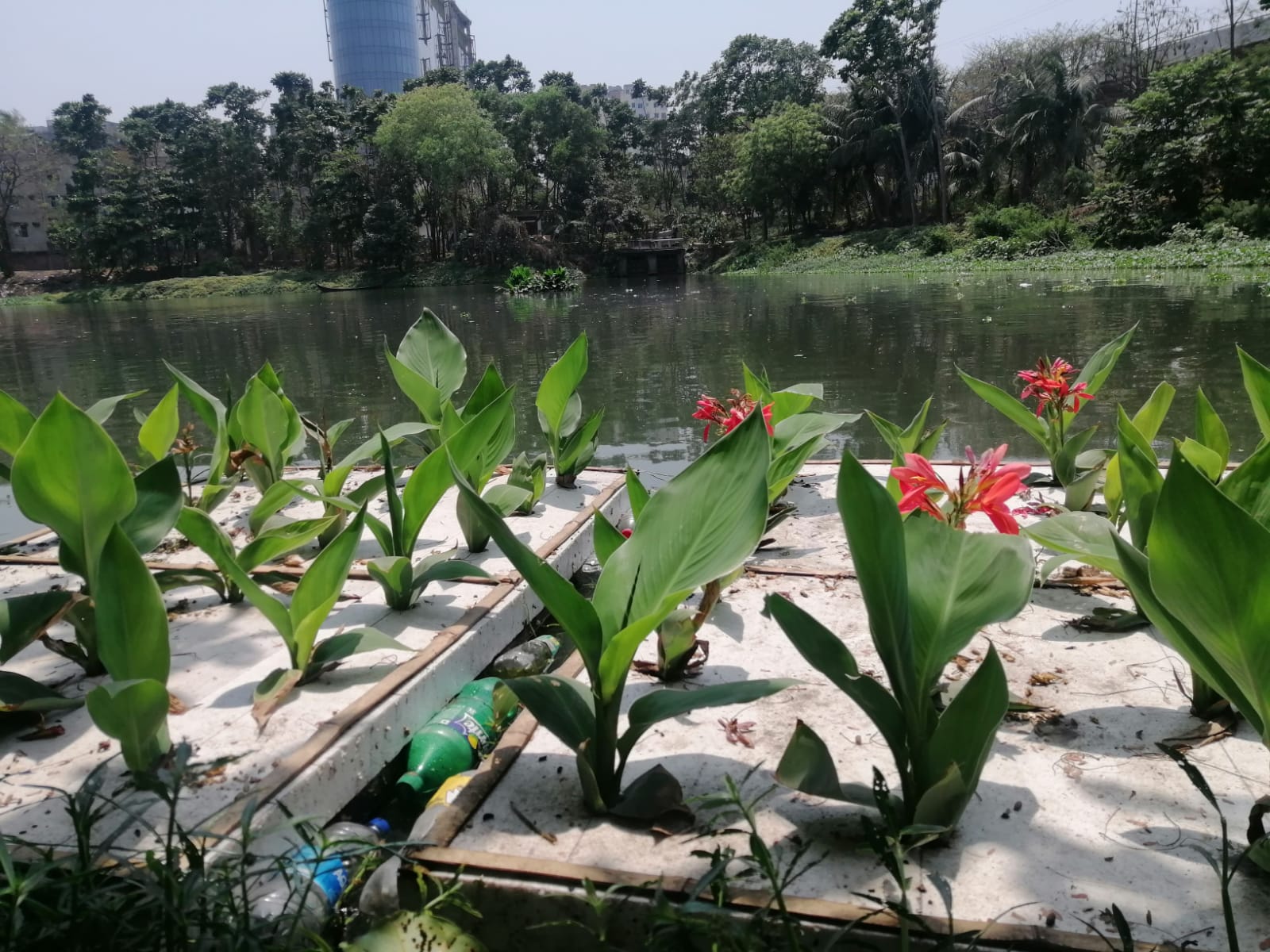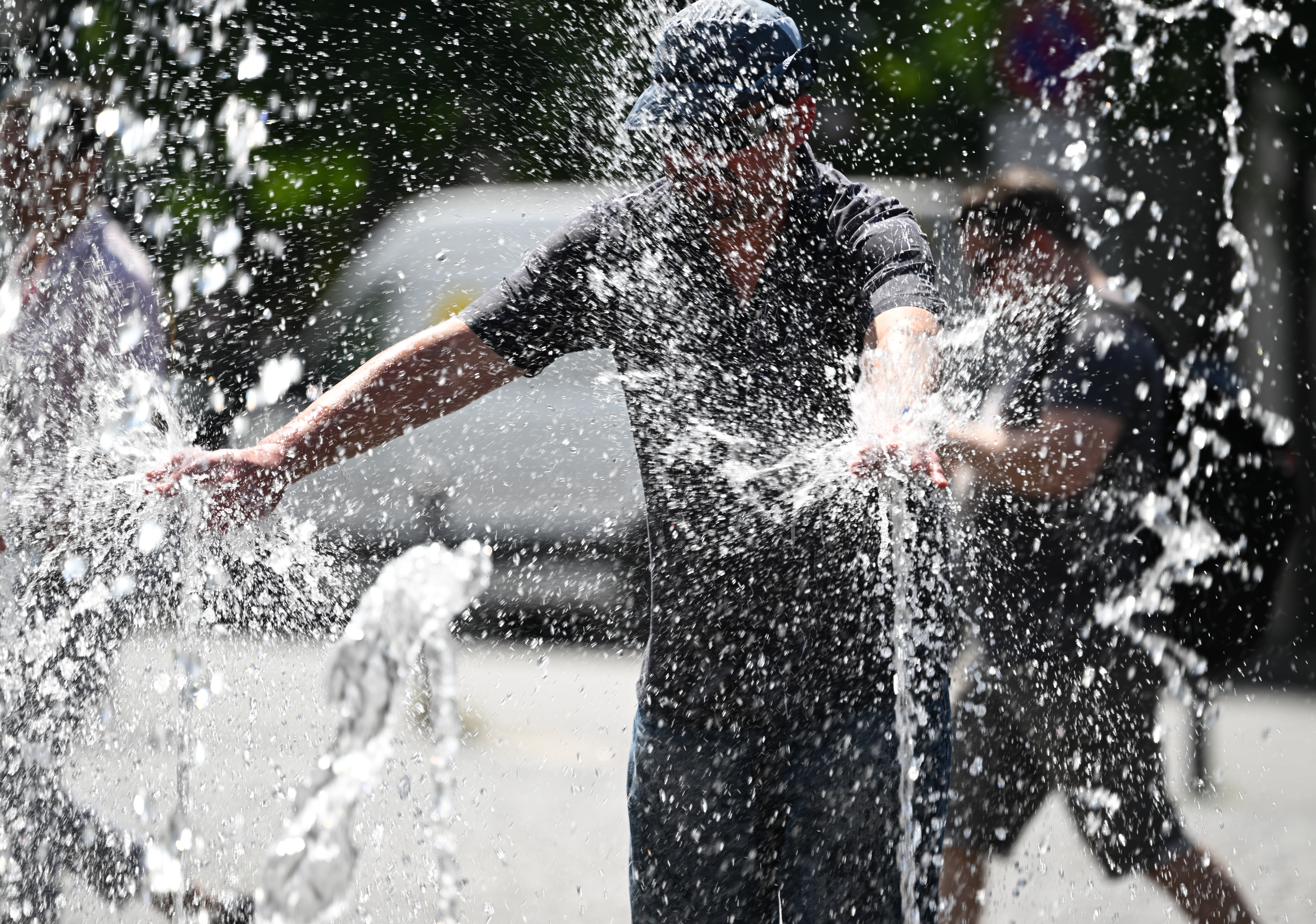Polluted Lakes Are Being Cleansed Using Floating Wetlands Made of Trash

On the banks of Nagdaha, a polluted and lotus-infested lake in Nepal, Soni Pradhanang is putting trash back into the water—on purpose.
She carefully assembles a platform of styrofoam and bamboo mats, then weaves it together with zip ties and coconut fiber, refuse from nearby tech stores. Then, she pokes 55 plants lush with red flowers through 2-inch holes in the platform, each plant set 6 inches apart. Though Pradhanang’s creation isn’t high-tech, it is effective, and one of the most affordable water-filtration systems available. “I’m cheap,” she says, laughing.
Pradhanang, a hydrologist at the University of Rhode Island who studies water-quality monitoring and modeling, has spent the past seven years working on her trash-based contraptions. Called floating treatment wetland systems (FTWS), these are 4-foot by 6-foot buoyant platforms topped with plants. When their roots are submerged in contaminated water, the plants suck pollutants into their stems and leaves as they grow. In turn, they leave behind dissolved oxygen captured during photosynthesis, which supports life beneath the surface.
The hope with these devices is two-fold: that they will cleanse waters and recycle rubbish in parts of the world where budgets for either are incredibly tight.
Pradhanang is also the chief scientific technical adviser to The Small Earth Nepal, a Kathmandu Valley–based research and community engagement group. It has spent around five years building, testing, and implementing the first known trash-based wetland water-cleaning systems here in Nagdaha’s polluted waters, which contain high concentrations of nitrates and phosphates due to agricultural and urban runoff. Pradhananag and The Small Earth Nepal also operate sites with collaborators in Ajmer, India, and Dhaka, Bangladesh.
Groups of platforms installed in Nagdaha lake in Nepal.
Photograph: Samyak Prajapati/The Small Earth Nepal
These floating treatment systems aren’t huge—each mat is around the dimensions of a full-size mattress—but they can connect to form clusters that treat larger areas of water. In Nagdaha, where FTWS have been bobbing lazily for nearly two years, there are five clusters, each with eight platforms. Results from The Small Earth Nepal show that the systems significantly reduce concentrations of nitrates, heavy metals, and phosphorus in the lake.
Pradhanang has always looked to South Asia for her water-quality projects. Born and raised in Kathmandu, Nepal, she intimately understands the water challenges Nepalese citizens face, including pollution in lakes and rivers from sewage, industry, and agriculture, limited water treatment facilities, and the need to use the same water body for multiple purposes, like washing clothes and bathing. Before the floating wetland project, Pradhanang worked with local farmers and foresters in Nepal to address their water needs in the face of climate change.
“My roots are back there,” says Pradhanang. “I am sort of automatically drawn towards the community that I have been a part of.”
In the US, floating treatment wetland systems have been steadily increasing over the past few years, driven both by companies scaling up production of proprietary, non-trash-based platforms, and cities taking note of others’ successes. Urban waterways like Baltimore’s Inner Harbor, Boston’s Charles River, and the Chicago River have all successfully deployed FTWS to clean their waters.
When Pradhanang wanted to try the systems on polluted water bodies in Nepal, she saw a barrier: They’re too expensive. The proprietary bases, which are usually made from recycled and water-resistant materials, cost upwards of $600 each in 2018. “That’s gonna be, what, 70,000 Nepalese rupees apiece? That’s somebody’s one-year salary,” she says.
Instead, Pradhanang developed a method she calls “trash for cash,” where the “cash” is improved water quality. If you build the mats using local waste, she reasoned, they become nearly free. She first tested the idea in her Rhode Island lab in 2017, with materials like oyster traps, bubble wrap, and BPA-free plastic water bottles, to see if trash-based mats loaded with plants could improve water quality.
A floating treatment wetland system loaded with plants.
Photograph: Samyak Prajapati/The Small Earth Nepal
Building your own FTWS is “a lot harder than you think,” says Sarah White, a water quality and treatment scientist at Clemson University in South Carolina. “There are not a lot of buoyant materials that remain watertight over time.”
When Pradhanang found a trash mix that could be fashioned into a platform and resist breaking down with age, she began talking to her colleagues in Nepal. By 2021, they had secured $78,000 in funding from the Asia-Pacific Network for Global Change Research, a research and policy funder, to operate a study across Nepal, India, and Bangladesh.
While Nagdaha and the Indian and Bangladeshi sites do not provide residents with drinking water, they do have cultural and religious significance. On her many visits to Nepal, Pradhanang has seen children swimming in Nagdaha’s murky water, dogs lapping at the shore, and women sitting on the banks to wash dishes and clothing. Pradhanang and The Small Earth Nepal wanted to beautify the lake as they cleaned it. They chose flowering plants that served both purposes: Indian shot (Canna indica) and scarlet sage (Salvia splendens), whose bright red flowers stand out against the gray water.
After installing the floating platforms in the fall of 2022, the researchers tested the water monthly and found results consistent with their lab trials, which showed a 99 percent reduction in nitrate levels, 80 percent reduction in phosphates, 56 percent reduction in iron, and 55 percent reduction in ammonia. Dissolved oxygen concentrations increased by half. Their results have been submitted to the Journal of Civil Engineering for review.
Growing flowering plants can add aesthetic value to a body of water, but the collaboration is staying away from growing food on the platforms, since the plants build up such high concentrations of pollutants. But people aren’t the only ones intrigued by the floating wetlands; geese and ducks flock to the mats, sitting on the platforms and pooping phosphorus-rich excrement into the water.
Pradhanang came up with a clever solution for the mischievous mallards: She tied silver ribbons around the stems of the plants, whose sharp glare drove away the birds. Though the scientists don’t want geese on the FTWS, pollinators like bees and small birds are more than welcome—as are the diverse microbial life-forms that exist on the plant roots and digest pollutants in the water for energy.
“There’s a real kind of, ‘If you build it, they will come’ phenomenon that’s associated with the floating wetlands,” says Max Rome, who did his PhD on FTWS in Boston’s Charles River and now works at the Charles River Watershed Association. “These systems are really effective for creating wetland biodiversity in a place where there’s just not room for wetlands.”
Though the trash-based systems solve some water-pollution problems, they leave others—namely, microplastics. Incorporating local trash into the mats shouldn’t make things worse overall—much of the trash is gathered from the water in the first place—but high plastic content in the water means that it can remain a risk to locals’ health, even after cleansing.
While Pradhanang and outside researchers have flagged concerns about incorporating styrofoam and other plastics into the trash-based FTWS, they say that the benefits of the mats generally outweigh the costs. “If you can use a waste product that would then just be normally in the water,” says White, “and you can use it to make a product that is actually helping to clean the water, it’s amazing.”
However, Pradhanang emphasizes that the floating treatment systems are only providing a net good if they are maintained properly; if people don’t take care of them, there’s the risk their components become unfastened and turn back into trash.
Community responses to the floating treatment wetland systems have largely been positive. But to give them staying power once the researchers leave, “we have to demonstrate the effectiveness of these systems,” explains Dr. Ritu Singh, an assistant professor at the Central University of Rajasthan and the FTWS collaboration’s lead for India. If residents don’t know the mats’ water-cleaning properties, the systems become “just a burden for locals to take care of,” she adds.
That’s not a problem specific to the tri-nation collaboration. White spoke of homeowners in the US South who didn’t know floating mats near their homes provided water treatment benefits, and a study on Sri Lankan floating wetlands found that locals often thought the systems were simply aesthetic.
Once locals are educated about the FTWS, their maintenance is pretty minimal—biannual prunings and root trimmings suffice. But with the grant money from the Asia-Pacific Network for Global Change Research all spent, Pradhanang and The Small Earth Nepal are in the process of transitioning the floating wetlands’ maintenance to local groups.
Throughout the past year, the collaboration has run workshops on the systems’ benefits and care instructions, as well as a policy briefing to the mayors, water chairmen, and community groups at all three sites. They are also offering advertising space on the sides of the platforms to incentivize people to take ownership of the systems and use the money generated to maintain them.
To expand beyond the three research sites—let alone maintain the ones that exist—the researchers emphasize the need for local policy and funding. While the FTWS are low-cost, money is still needed to cover people’s time and labor, as well as the bamboo mats and plants used in the platforms.
The Small Earth Nepal reported that the Kathmandu Valley Water Supply Board has shown interest in implementing the FTWS at other sites, and Pradhanang is traveling to Nepal this month to discuss next steps. She has also shared the methods of her trash-based FTWS experiments with a university in Banjarmasin, Indonesia, which is hoping to try these systems on its own polluted waters.
Though funding and scale are always in the back of her mind, Pradhanang has found that communicating with local residents about their needs and opinions is the most important step towards success with floating treatment wetland systems. “We talk about phosphorus, we talk about ammonia, we talk about nitrate—for a community, it means nothing,” she says. “For a community, they need clean water.”
The world needs protecting, now more than ever. But preserving the natural world and advancing human knowledge requires innovative and pioneering solutions. In this series, WIRED, in partnership with the Rolex Perpetual Planet Initiative, highlights the individuals and communities working to solve some of our most pressing environmental and scientific challenges. Through the Perpetual Planet Initiative, Rolex supports those who go above and beyond to safeguard and preserve our planet for the next generations. #PerpetualPlanet #PlanetPioneers






